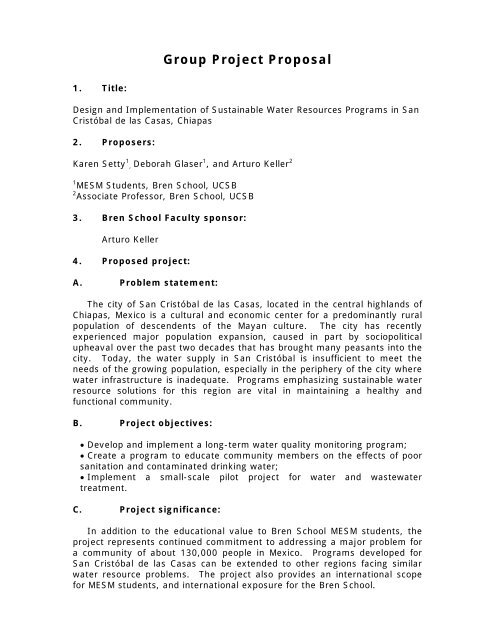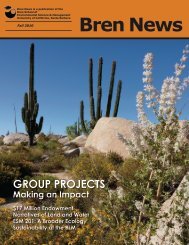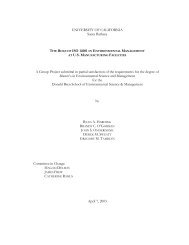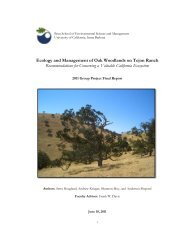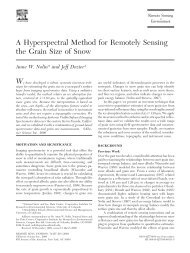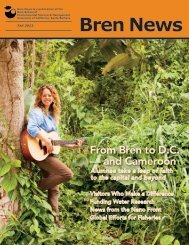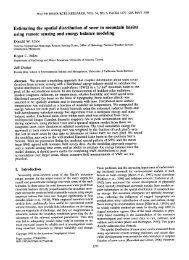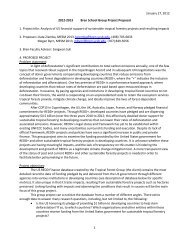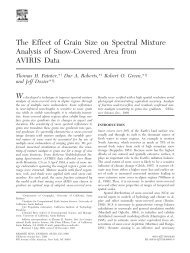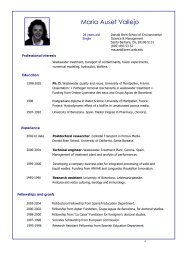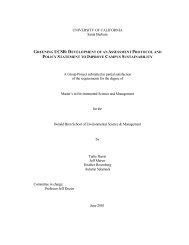Group Project Proposal - Bren School of Environmental Science ...
Group Project Proposal - Bren School of Environmental Science ...
Group Project Proposal - Bren School of Environmental Science ...
You also want an ePaper? Increase the reach of your titles
YUMPU automatically turns print PDFs into web optimized ePapers that Google loves.
<strong>Group</strong> <strong>Project</strong> <strong>Proposal</strong><br />
1. Title:<br />
Design and Implementation <strong>of</strong> Sustainable Water Resources Programs in San<br />
Cristóbal de las Casas, Chiapas<br />
2. Proposers:<br />
Karen Setty 1 , Deborah Glaser 1 , and Arturo Keller 2<br />
1 MESM Students, <strong>Bren</strong> <strong>School</strong>, UCSB<br />
2 Associate Pr<strong>of</strong>essor, <strong>Bren</strong> <strong>School</strong>, UCSB<br />
3. <strong>Bren</strong> <strong>School</strong> Faculty sponsor:<br />
Arturo Keller<br />
4. Proposed project:<br />
A. Problem statement:<br />
The city <strong>of</strong> San Cristóbal de las Casas, located in the central highlands <strong>of</strong><br />
Chiapas, Mexico is a cultural and economic center for a predominantly rural<br />
population <strong>of</strong> descendents <strong>of</strong> the Mayan culture. The city has recently<br />
experienced major population expansion, caused in part by sociopolitical<br />
upheaval over the past two decades that has brought many peasants into the<br />
city. Today, the water supply in San Cristóbal is insufficient to meet the<br />
needs <strong>of</strong> the growing population, especially in the periphery <strong>of</strong> the city where<br />
water infrastructure is inadequate. Programs emphasizing sustainable water<br />
resource solutions for this region are vital in maintaining a healthy and<br />
functional community.<br />
B. <strong>Project</strong> objectives:<br />
• Develop and implement a long-term water quality monitoring program;<br />
• Create a program to educate community members on the effects <strong>of</strong> poor<br />
sanitation and contaminated drinking water;<br />
• Implement a small-scale pilot project for water and wastewater<br />
treatment.<br />
C. <strong>Project</strong> significance:<br />
In addition to the educational value to <strong>Bren</strong> <strong>School</strong> MESM students, the<br />
project represents continued commitment to addressing a major problem for<br />
a community <strong>of</strong> about 130,000 people in Mexico. Programs developed for<br />
San Cristóbal de las Casas can be extended to other regions facing similar<br />
water resource problems. The project also provides an international scope<br />
for MESM students, and international exposure for the <strong>Bren</strong> <strong>School</strong>.
D. Background information:<br />
The Mexican state <strong>of</strong> Chiapas is home to one <strong>of</strong> the highest concentrations<br />
<strong>of</strong> indigenous populations in the Americas (Figure 1). According to the 2000<br />
census, 25% percent <strong>of</strong> the population in Chiapas speaks an indigenous<br />
tongue as their primary language, compared to the national average <strong>of</strong> 5%<br />
(INEGI, 2005). Chiapas is one <strong>of</strong> the poorest states in Mexico. Mortality<br />
rates in children under 5 are additionally the highest <strong>of</strong> any state in Mexico<br />
(INSP, 2000).<br />
Over the last decade, a large number <strong>of</strong> indigenous people from the<br />
highlands <strong>of</strong> Chiapas have concentrated along the periphery <strong>of</strong> the urban<br />
center, San Cristóbal, and now exert a strain on the city’s tenuous<br />
infrastructure. It is estimated that more than 40,000 <strong>of</strong> the current 132,000<br />
inhabitants <strong>of</strong> the city were displaced from their rural communities and are<br />
currently residing along the periphery in neighborhoods that are collectively<br />
referred to as “the belt <strong>of</strong> misery.” Although many <strong>of</strong> these people were<br />
displaced by civil unrest, they will probably stay in San Cristóbal, since they<br />
also seek employment to have a more stable income.<br />
The combination <strong>of</strong> diminished spring water supplies and population<br />
growth has caused extreme inadequacies in the potable water supply to the<br />
city <strong>of</strong> San Cristóbal. Currently, the city's water supply is so overtaxed that<br />
the operators are forced to alternate flow to different neighborhoods<br />
throughout the course <strong>of</strong> the day. In the poorest neighborhoods, the public<br />
spigot is left wide open, with buckets stacked nearby. When the water starts<br />
gushing from the spigot the call is raised and everyone races to fill their<br />
buckets. It’s not uncommon that this occurs in the late night and early<br />
morning.<br />
Currently, wastewater in the city is not treated. The primary rivers, the<br />
Río Amarillo and Río Fogotico, are heavily contaminated with raw sewage and<br />
sediments (SAPAM, 2003). These waters are used below the city for<br />
agriculture – mainly fruits and berries that are sold in San Cristóbal and<br />
other parts <strong>of</strong> Mexico. In the low-lying areas <strong>of</strong> the basin, groundwater is<br />
found less than 50 cm below the soil. The proximity <strong>of</strong> this water to the<br />
surface has caused widespread contamination with pathogens, among other<br />
contaminants. Population growth also increases the concentration <strong>of</strong><br />
pathogenic organisms. It is common knowledge in the city that this water<br />
will make you sick, and it is not considered potable by the residents.<br />
F. Stakeholders:<br />
SYJAC – Skolta'el Yu'un Jlumaltic, A.C. is a nonpr<strong>of</strong>it organization based in<br />
Mexico, whose objective is to support community building and improved life<br />
quality in the indigenous communities around San Cristóbal. SYJAC regularly<br />
participates in the execution <strong>of</strong> sustainable works projects in indigenous<br />
communities, including potable water supply and auto-digesting latrines.<br />
SYJAC has a working relationship with Habitat for Humanity. URL:<br />
http://www.syjac.org
ECOSUR, Chiapas – ECOSUR (El Colegio de la Frontera Sur) is a publicly<br />
chartered research institution providing research and post-graduate<br />
education focused primarily on the development and linkage <strong>of</strong> Mexico's<br />
southern-most states. ECOSUR maintains five campuses, including a campus<br />
in San Cristóbal. Two hydrologists, Duncan Goliche and Jesus Carmona<br />
participate as contacts and members in the SHR Partnership. URL:<br />
http://www.ecosur.mx<br />
City <strong>of</strong> San Cristóbal – In 2004 several organizations recognized a common<br />
concern for sustainable water resources management in the city <strong>of</strong> San<br />
Cristóbal and rural periphery. The organizations formed a partnership, the<br />
San Cristóbal Hydro-Resources Partnership (SHRP) with the collective goal <strong>of</strong><br />
investigating the water cycle in San Cristóbal and developing a plan for<br />
sustainable use and urban growth within the basin. By combining the<br />
resources and capacities <strong>of</strong> the member institutions, the Partnership is in the<br />
best possible position to rigorously study the system, define needs <strong>of</strong> the<br />
population, and affect policy change that is rooted upon a scientific<br />
understanding <strong>of</strong> system and focused ideal <strong>of</strong> sustainability. The<br />
participating entities include research universities, community-based<br />
nonpr<strong>of</strong>it organizations, and a government-chartered citizen advisory board.<br />
G. Approach:<br />
Students applying to this group project should have a working<br />
understanding <strong>of</strong> the Spanish language. A primary resource available to<br />
students will be the sustainable watershed management plan created<br />
through the class <strong>of</strong> 2006 group project: Developing a sustainable water<br />
resources management plan for San Cristóbal de las Casas, Chiapas.<br />
Recommendations from this source, along with additional research into<br />
appropriate technologies, will provide the basis for design <strong>of</strong> a small-scale<br />
water treatment demonstration project. If funding becomes available,<br />
materials may be purchased for project members to assist in building the<br />
system and training local community members to maintain it.<br />
Educational materials linking water quality and human health will be<br />
developed as well. These should cover simple hygiene and sanitation<br />
measures that can be taken to reduce the risk <strong>of</strong> waterborne diseases. The<br />
program will be primarily targeted towards elementary school-aged children,<br />
and lessons designed with the intention that children disseminate information<br />
to family, friends and neighbors. SYJAC partners are expected to utilize<br />
these materials in community outreach.<br />
A water quality monitoring plan covering broadly the city’s watershed<br />
would indicate where existing problems are being corrected by management<br />
policies, while revealing emergent changes that may require adaptive<br />
management. Sites for monitoring may be determined using available GIS<br />
data and an on-site field survey. Measurement <strong>of</strong> water quality parameters<br />
and flow data will need to utilize appropriate, available, and cost-effective<br />
technologies. Problems with sustaining the monitoring program over a long<br />
period <strong>of</strong> time will need to be specifically addressed. ECOSUR partners are<br />
likely to be involved in data processing and reporting.
H. Deliverables:<br />
• Materials for water treatment pilot project and maintenance instructions.<br />
• Educational materials including worksheets, fact sheets and lesson<br />
plans.<br />
• Directions for long-term water resource monitoring methods and<br />
mapped sampling locations.<br />
I. References:<br />
Consejo Consultivo de SAPAM, (September, 2003). El Tachilguil.<br />
[Newsletter], San Cristobal de las Casas, Chiapas, Mexico.<br />
Instituto Nacional de Estadística Geografía e Informática [INEGI] (2005).<br />
Online: URL: http://www.inegi.gob.mx<br />
Instituto Nacional de Salud Publica. http://www.ins.gob.pe (2000)<br />
5. Client:<br />
ECOSUR – primary contact is Jesus Carmona<br />
6. Anticipated Financial Needs:<br />
$1,000/person for trip and supplies x 6 students<br />
$1,000 for water quality testing supplies<br />
Total: approx. $7,000<br />
Potential Sources <strong>of</strong> Support:<br />
MESM group project allocated funds – $1,100<br />
UC MEXUS Grants (http://ucmexus.ucr.edu/) – The UC MEXUS grant<br />
program provides seed funding for research in collaboration with Mexican<br />
agencies and institutions to enhance ongoing research and education<br />
programs at UC and in Mexico. Previous year’s group project received<br />
$14,000 in funding. (Will apply for a renewal grant March 27 th , 2006).<br />
<strong>Environmental</strong> Resources Management (www.erm.com) – One <strong>of</strong> the <strong>Bren</strong><br />
<strong>School</strong>’s corporate partners, ERM is a provider <strong>of</strong> environmental consulting<br />
services. The firm has <strong>of</strong>fices in 37 countries, working globally and locally<br />
providing solutions for a wide range <strong>of</strong> specific environmental needs. ERM<br />
delivers innovative solutions for business and government clients, assisting<br />
them in managing their environmental and related risks. Previous year’s<br />
group project received $4,000 from the ERM Foundation, and we will request<br />
funding for this year.
Appendix:<br />
Figure 1: Location and primary waterways <strong>of</strong> San Cristóbal de las Casas, Chiapas,<br />
Mexico. Source: INEGI, URL: http://www.inegi.gob.mx.


